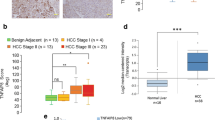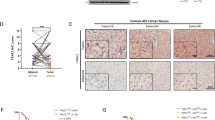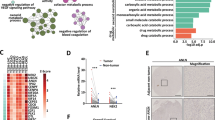Abstract
Angiomotin-like 2 (AMOTL2) is a member of Angiomotin family proteins, which are potent inhibitors for the Hippo pathway effector YAP. However, additional cellular functions of AMOTL2 besides YAP inhibition are largely unknown. Here, we reported that AMOTL2 associates with and negatively regulates AKT. Mechanistically, AMOTL2 binds to AKT pleckstrin homology domain and interrupts AKT’s membrane localization. Liver-specific depletion of AMOTL2 enlarged mouse liver and activated both YAP and AKT. Downregulation of AMOTL2 is found in human liver cancers, correlating with the concomitant activation of YAP and AKT. Together, our results provide novel insights into a dual tumor suppressive function of AMOTL2 by targeting both YAP and AKT in liver size control and cancer prevention.
This is a preview of subscription content, access via your institution
Access options
Subscribe to this journal
Receive 50 print issues and online access
$259.00 per year
only $5.18 per issue
Buy this article
- Purchase on Springer Link
- Instant access to full article PDF
Prices may be subject to local taxes which are calculated during checkout




Similar content being viewed by others
References
Pan D . Hippo signaling in organ size control. Genes Dev 2007; 21: 886–897.
Johnson R, Halder G . The two faces of Hippo: targeting the Hippo pathway for regenerative medicine and cancer treatment. Nat Rev Drug Discov 2014; 13: 63–79.
Yu FX, Zhao B, Guan KL . Hippo pathway in organ size control, tissue homeostasis, and cancer. Cell 2015; 163: 811–828.
Meng Z, Moroishi T, Mottier-Pavie V, Plouffe SW, Hansen CG, Hong AW et al. MAP4K family kinases act in parallel to MST1/2 to activate LATS1/2 in the Hippo pathway. Nat Commun 2015; 6: 8357.
Lu L, Li Y, Kim SM, Bossuyt W, Liu P, Qiu Q et al. Hippo signaling is a potent in vivo growth and tumor suppressor pathway in the mammalian liver. Proc Natl Acad Sci USA 2010; 107: 1437–1442.
Zhou D, Conrad C, Xia F, Park JS, Payer B, Yin Y et al. Mst1 and Mst2 maintain hepatocyte quiescence and suppress hepatocellular carcinoma development through inactivation of the Yap1 oncogene. Cancer Cell 2009; 16: 425–438.
Zhang N, Bai H, David KK, Dong J, Zheng Y, Cai J et al. The Merlin/NF2 tumor suppressor functions through the YAP oncoprotein to regulate tissue homeostasis in mammals. Dev Cell 2010; 19: 27–38.
Camargo FD, Gokhale S, Johnnidis JB, Fu D, Bell GW, Jaenisch R et al. YAP1 increases organ size and expands undifferentiated progenitor cells. Curr Biol 2007; 17: 2054–2060.
Nishio M, Sugimachi K, Goto H, Wang J, Morikawa T, Miyachi Y et al. Dysregulated YAP1/TAZ and TGF-beta signaling mediate hepatocarcinogenesis in Mob1a/1b-deficient mice. Proc Natl Acad Sci USA 2016; 113: E71–E80.
Lee KP, Lee JH, Kim TS, Kim TH, Park HD, Byun JS et al. The Hippo-Salvador pathway restrains hepatic oval cell proliferation, liver size, and liver tumorigenesis. Proc Natl Acad Sci USA 2010; 107: 8248–8253.
Harvey KF, Zhang X, Thomas DM . The Hippo pathway and human cancer. Nat Rev 2013; 13: 246–257.
Zhao B, Li L, Lu Q, Wang LH, Liu CY, Lei Q et al. Angiomotin is a novel Hippo pathway component that inhibits YAP oncoprotein. Genes Dev 2011; 25: 51–63.
Chan SW, Lim CJ, Chong YF, Pobbati AV, Huang C, Hong W . Hippo pathway-independent restriction of TAZ and YAP by angiomotin. J Biol Chem 2011; 286: 7018–7026.
Yi C, Shen Z, Stemmer-Rachamimov A, Dawany N, Troutman S, Showe LC et al. The p130 isoform of angiomotin is required for Yap-mediated hepatic epithelial cell proliferation and tumorigenesis. Sci Signal 2013; 6: ra77.
Paramasivam M, Sarkeshik A, Yates JR III, Fernandes MJ, McCollum D . Angiomotin family proteins are novel activators of the LATS2 kinase tumor suppressor. Mol Biol Cell 2011; 22: 3725–3733.
Kim M, Kim M, Park SJ, Lee C, Lim DS . Role of Angiomotin-like 2 mono-ubiquitination on YAP inhibition. EMBO Rep 2016; 17: 64–78.
Adler JJ, Johnson DE, Heller BL, Bringman LR, Ranahan WP, Conwell MD et al. Serum deprivation inhibits the transcriptional co-activator YAP and cell growth via phosphorylation of the 130-kDa isoform of Angiomotin by the LATS1/2 protein kinases. Proc Natl Acad Sci USA 2013; 110: 17368–17373.
Wang W, Huang J, Chen J . Angiomotin-like proteins associate with and negatively regulate YAP1. J Biol Chem 2011; 286: 4364–4370.
Li Y, Zhou H, Li F, Chan SW, Lin Z, Wei Z et al. Angiomotin binding-induced activation of Merlin/NF2 in the Hippo pathway. Cell Res 2015; 25: 801–817.
Wang W, Li N, Li X, Tran MK, Han X, Chen J . Tankyrase inhibitors target YAP by stabilizing Angiomotin family proteins. Cell Rep 2015; 13: 524–532.
Wang H, Lu B, Castillo J, Zhang Y, Yang Z, McAllister G et al. Tankyrase inhibitor sensitizes lung cancer cells to endothelial growth factor receptor (EGFR) inhibition via stabilizing Angiomotins and inhibiting YAP signaling. J Biol Chem 2016; 291: 15256–15266.
Troilo A, Benson EK, Esposito D, Garibsingh RA, Reddy EP, Mungamuri SK et al. Angiomotin stabilization by tankyrase inhibitors antagonizes constitutive TEAD-dependent transcription and proliferation of human tumor cells with Hippo pathway core component mutations. Oncotarget 2016; 7: 28765–28782.
Leung CY, Zernicka-Goetz M . Angiomotin prevents pluripotent lineage differentiation in mouse embryos via Hippo pathway-dependent and -independent mechanisms. Nat Commun 2013; 4: 2251.
Hirate Y, Hirahara S, Inoue K, Suzuki A, Alarcon VB, Akimoto K et al. Polarity-dependent distribution of angiomotin localizes Hippo signaling in preimplantation embryos. Curr Biol 2013; 23: 1181–1194.
Yi C, Troutman S, Fera D, Stemmer-Rachamimov A, Avila JL, Christian N et al. A tight junction-associated Merlin-angiomotin complex mediates Merlin's regulation of mitogenic signaling and tumor suppressive functions. Cancer Cell 2011; 19: 527–540.
Aase K, Ernkvist M, Ebarasi L, Jakobsson L, Majumdar A, Yi C et al. Angiomotin regulates endothelial cell migration during embryonic angiogenesis. Genes Dev 2007; 21: 2055–2068.
Mojallal M, Zheng Y, Hultin S, Audebert S, van Harn T, Johnsson P et al. AmotL2 disrupts apical-basal cell polarity and promotes tumour invasion. Nat Commun 2014; 5: 4557.
Lv M, Li S, Luo C, Zhang X, Shen Y, Sui YX et al. Angiomotin promotes renal epithelial and carcinoma cell proliferation by retaining the nuclear YAP. Oncotarget 2016; 7: 12393–12403.
Moleirinho S, Guerrant W, Kissil JL . The Angiomotins—from discovery to function. FEBS Lett 2014; 588: 2693–2703.
Alessi DR, Andjelkovic M, Caudwell B, Cron P, Morrice N, Cohen P et al. Mechanism of activation of protein kinase B by insulin and IGF-1. EMBO J 1996; 15: 6541–6551.
Vivanco I, Sawyers CL . The phosphatidylinositol 3-kinase AKT pathway in human cancer. Nat Rev 2002; 2: 489–501.
Liu P, Wang Z, Wei W . Phosphorylation of Akt at the C-terminal tail triggers Akt activation. Cell Cycle 2014; 13: 2162–2164.
Liu P, Begley M, Michowski W, Inuzuka H, Ginzberg M, Gao D et al. Cell-cycle-regulated activation of Akt kinase by phosphorylation at its carboxyl terminus. Nature 2014; 508: 541–545.
Chan TO, Zhang J, Tiegs BC, Blumhof B, Yan L, Keny N et al. Akt kinase C-terminal modifications control activation loop dephosphorylation and enhance insulin response. Biochem J 2015; 471: 37–51.
Jiang T, Qiu Y . Interaction between Src and a C-terminal proline-rich motif of Akt is required for Akt activation. J Biol Chem 2003; 278: 15789–15793.
Hemmings BA, Restuccia DF . PI3K-PKB/Akt pathway. Cold Spring Harb Perspect Biol 2012; 4: a011189.
Matter MS, Decaens T, Andersen JB, Thorgeirsson SS . Targeting the mTOR pathway in hepatocellular carcinoma: current state and future trends. J Hepatol 2014; 60: 855–865.
Luo J, Manning BD, Cantley LC . Targeting the PI3K-Akt pathway in human cancer: rationale and promise. Cancer Cell 2003; 4: 257–262.
Wang W, Xiao ZD, Li X, Aziz KE, Gan B, Johnson RL et al. AMPK modulates Hippo pathway activity to regulate energy homeostasis. Nat Cell Biol 2015; 17: 490–499.
Moroishi T, Park HW, Qin B, Chen Q, Meng Z, Plouffe SW et al. A YAP/TAZ-induced feedback mechanism regulates Hippo pathway homeostasis. Genes Dev 2015; 29: 1271–1284.
Dai X, Liu H, Shen S, Guo X, Yan H, Ji X et al. YAP activates the Hippo pathway in a negative feedback loop. Cell Res 2015; 25: 1175–1178.
Dai X, She P, Chi F, Feng Y, Liu H, Jin D et al. Phosphorylation of angiomotin by Lats1/2 kinases inhibits F-actin binding, cell migration, and angiogenesis. J Biol Chem 2013; 288: 34041–34051.
Chan SW, Lim CJ, Guo F, Tan I, Leung T, Hong W . Actin-binding and cell proliferation activities of angiomotin family members are regulated by Hippo pathway-mediated phosphorylation. J Biol Chem 2013; 288: 37296–37307.
Li Y, Tsang CK, Wang S, Li XX, Yang Y, Fu L et al. MAF1 suppresses AKT-mTOR signaling and liver cancer through activation of PTEN transcription. Hepatology 2016; 63: 1928–1942.
Xu MZ, Yao TJ, Lee NP, Ng IO, Chan YT, Zender L et al. Yes-associated protein is an independent prognostic marker in hepatocellular carcinoma. Cancer 2009; 115: 4576–4585.
Wang W, Chen L, Ding Y, Jin J, Liao K . Centrosome separation driven by actin-microfilaments during mitosis is mediated by centrosome-associated tyrosine-phosphorylated cortactin. J Cell Sci 2008; 121: 1334–1343.
Acknowledgements
WW thanks Dr Junjie Chen at MD Anderson Cancer Center for his mentoring and continuous support. We also thank Kathryn E Aziz and My Kim Tran at MD Anderson Cancer Center for the technical help. WW is a recipient of American Association for Cancer Research Career Development Award for Translational Breast Cancer Research supported by the Breast Cancer Research Foundation (16-20-26-WANG). This work was also partially supported by the American Cancer Society-Institutional Research Grant to WW. WW is a member of Chao Family Comprehensive Cancer Center (P30 CA062203) and a member of Center for Complex Biological Systems at UC Irvine.
Author contributions
WW conceived the experiments and wrote the manuscript. HH, BY and WW performed all of the experiments.
Author information
Authors and Affiliations
Corresponding author
Ethics declarations
Competing interests
The authors declare no conflict of interest.
Additional information
Supplementary Information accompanies this paper on the Oncogene website
Supplementary information
Rights and permissions
About this article
Cite this article
Han, H., Yang, B. & Wang, W. Angiomotin-like 2 interacts with and negatively regulates AKT. Oncogene 36, 4662–4669 (2017). https://doi.org/10.1038/onc.2017.101
Received:
Revised:
Accepted:
Published:
Issue Date:
DOI: https://doi.org/10.1038/onc.2017.101
This article is cited by
-
The physiological role of Motin family and its dysregulation in tumorigenesis
Journal of Translational Medicine (2018)



